Long gone are the days of strolling into a CompUSA or Best Buy and picking up whatever high capacity IDE harddrive was on sale and slapping it into a modded original Xbox. IDE drives are now an all but forgotten relic of years gone by superseded by far more modern storage technologies such as Serial ATA (SATA), and even direct attached PCI Express based solutions such as NVME.
By the mid 2000s IDE harddrives were already on their way out and being replaced with SATA drives. SATA drives offered many benefits over their IDE counterparts such as no longer requiring jumpers to be set for Master, Slave or Cable Select operation and gone was the requirement of the air flow blocking IDE ribbon cables instead replaced with a thin SATA data cable. Rather than chaining multiple drives to 1 IDE ribbon cable in a Slave and Master configuration, SATA moved to a 1 device per port style configuration. SATA also offered the benefit of supporting far greater transfer speeds than IDE ever did which allowed for things like Solid State Drives to become commonplace in computers starting about 5 or 6 years ago.
And this brings us to the subject of this article: What kind of performance advantage do SATA drives deliver in comparison to the older IDE drives in the original Xbox? And for good measure, what kind of performance increase or decrease does different types of Solid State media provide in comparison to spinning hard drives?
To use a SATA drive in the OG Xbox, we need to adapt the IDE connection to SATA. For this article I have chosen the Startech IDE to SATA bridge adapter with the model number IDE2SAT2. Simply plug it into the end of the IDE cable, and set the jumper to the correct settings (cable select). We also need one more thing: an 80wire IDE cable. The stock IDE cable in the Xbox is a 40 wire ribbon cable and unfortunately will not work with any IDE to SATA bridge adapter. You have to replace it with an 80 wire IDE cable to work. The stock cable is 24 inches long, however an 18 inch one will work with some finessing. And according to this article, an 80 wire IDE cable will deliver 25% faster load times over a 40 wire IDE cable. However the article doesn’t specify if that faster loading time was when the game was played from DVD or if the game was played from hard drive. I suspect from DVD.
I also decided to include a high performance SD card into the mix along with an IDE to SD card adapter. I’ve used SD cards as hard drive replacements in retro computers in the past and wanted to see what kind of affect it would have on the Xbox if any. I wanted to also test Compact Flash, however I couldn’t get the Xbox to work with any of my IDE to compact flash adapters as I own a couple of them. I know it’s possible as Modern Vintage Gamer has shown it, but sadly it wasn’t working on my end so I had to omit it.
Link to Startech IDE to SATA adapter: https://amzn.to/2TIZmtz
Link to 18 inch 80 wire cable: https://amzn.to/3gtB7JI
Link to 3.5″ to 2.5″ drive/tray adapter: https://amzn.to/3grvECP
Link to IDE to SD Card adapter: https://amzn.to/3eiysAz
And our contestants:
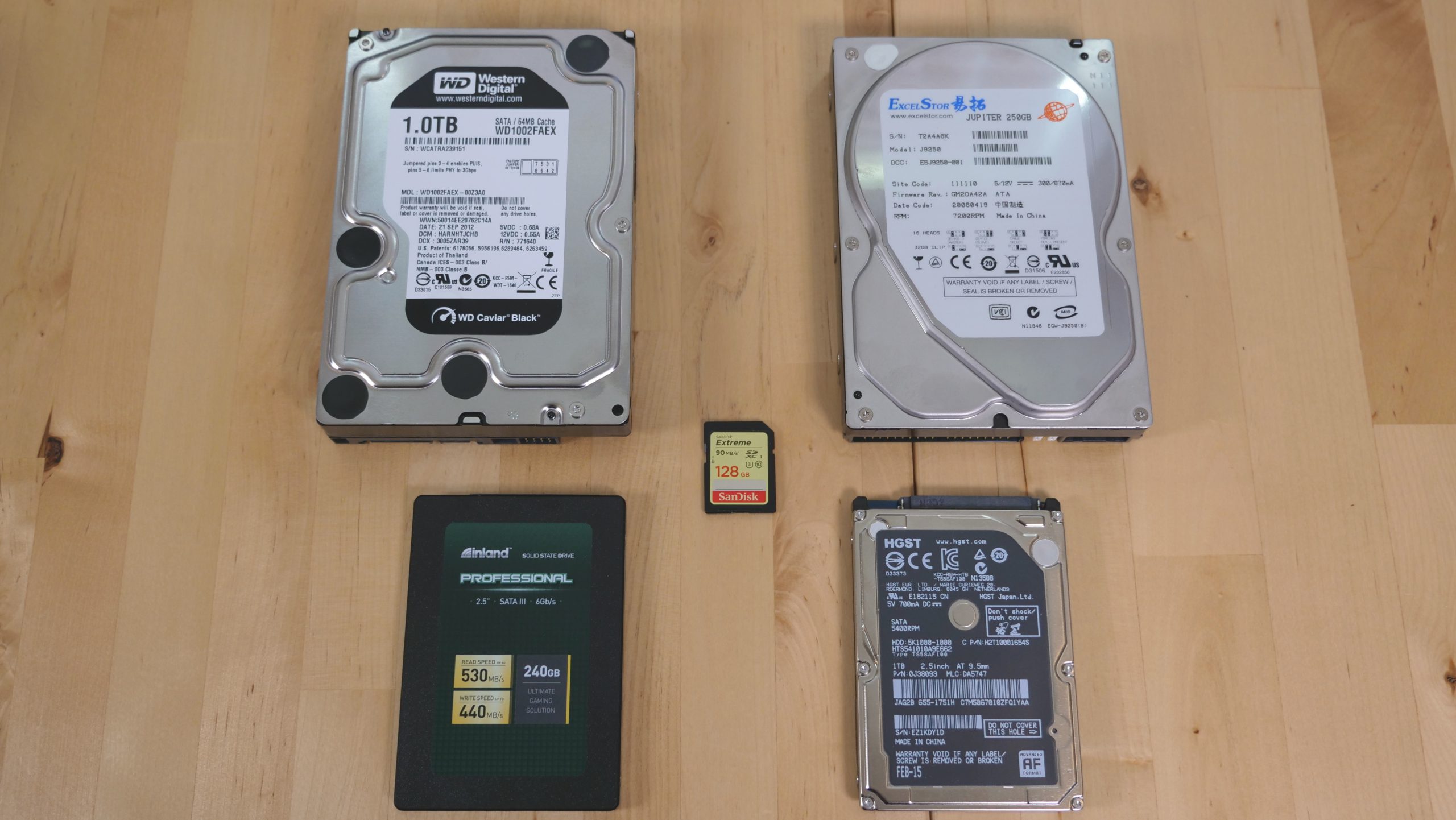
For drives I choose:
7200 RPM IDE ExcelStor Jupitor 250GB 3.5″ desktop drive – This drive represents a faster IDE drive from the Xbox heyday.
7200 RPM SATA Western Digital Black 1TB 3.5″ desktop drive – Modern balls to the wall high speed SATA hard disk.
5400 RPM SATA HGST 1TB 2.5″ laptop drive – Typical laptop style middle of the road performance drive
128GB Sandisk Extreme U3 SD card – High end SD card. I use this same card in my GH5 for 4k video footage.
240GB Inland SATA SSD – Budget priced SSD from Microcenter.
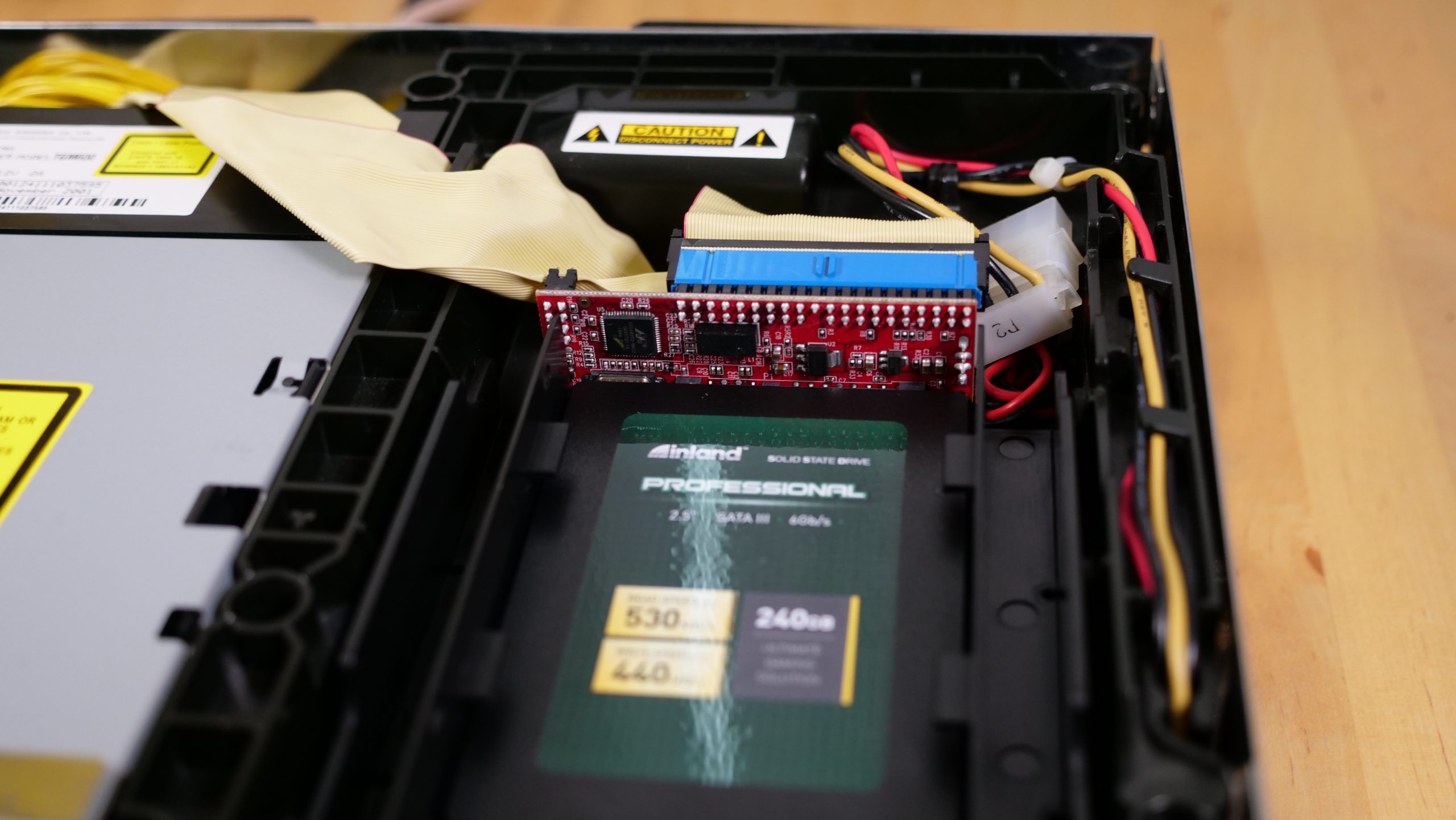
All drives were setup using the HeXEn 2018 setup disc and had UnleashX as the dashboard.
All games were copied to the drive on the F: partition and ran from there as I believe this represents a fair comparison rather than loading from DVD plus more accurately represents one of the reasons to install a larger drive in your Xbox to begin with.
Without further ado, lets get onto the different load time charts. All tests rounded near the nearest half second and all SATA drives are using the 80 wire IDE cable as it’s a requirement for the SATA bridge adapter to function.
Crimson Skies load time
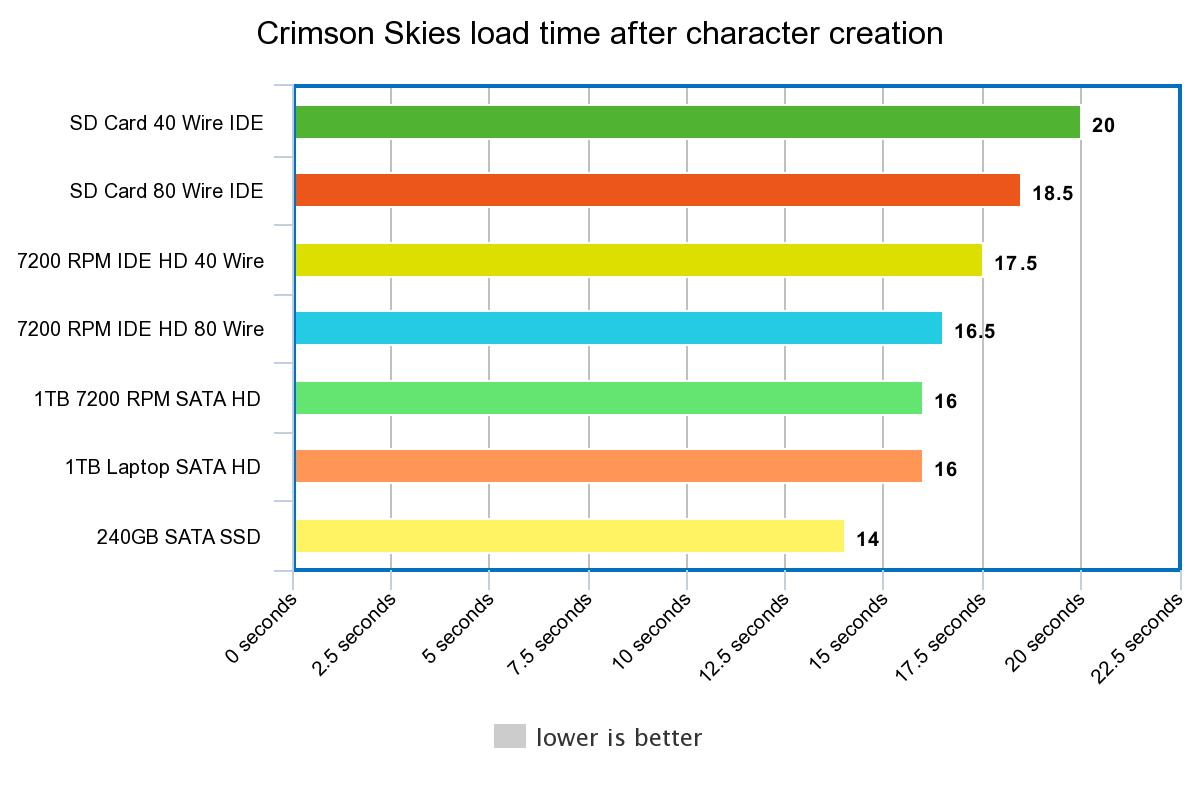
Crimson Skies shows a clear advantage to the SSD while most of the spinning hard drives are within 1.5 seconds of each other. And coming in last is the SD card. The SD card here shows a small advantage to using the 80 wire IDE cable as does the 7200 RPM IDE hard drive.
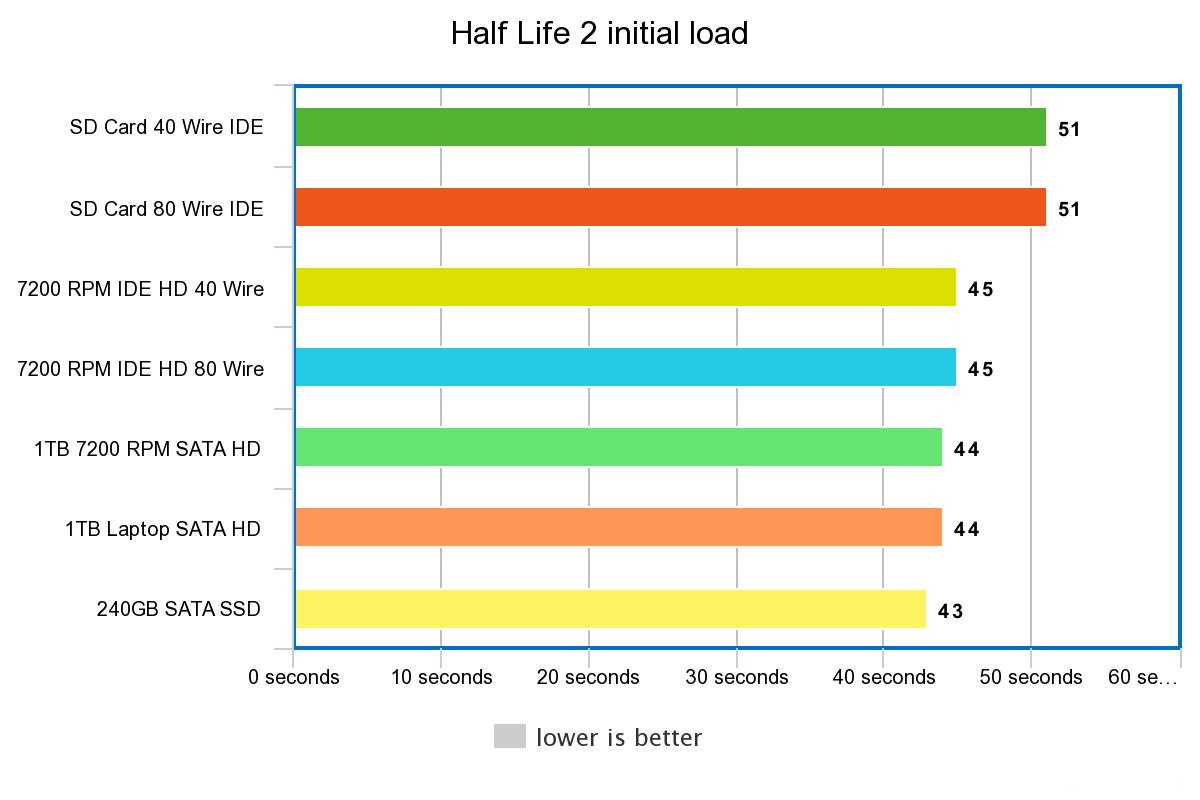
Half Life 2 shows all of the hard drives and SSD in a neck to neck race with only 2 seconds separating the SSD from the slowest 7200 RPM IDE drive. The SD card is the big loser coming 6 seconds behind the rest of the pack. Interesting to note that the 80 wire IDE cable had zero effect here. I believe this is because Half Life 2 does some pretty heaving drive caching during this initial load dropping about 600 megabytes of data onto the cache partition of the drive.
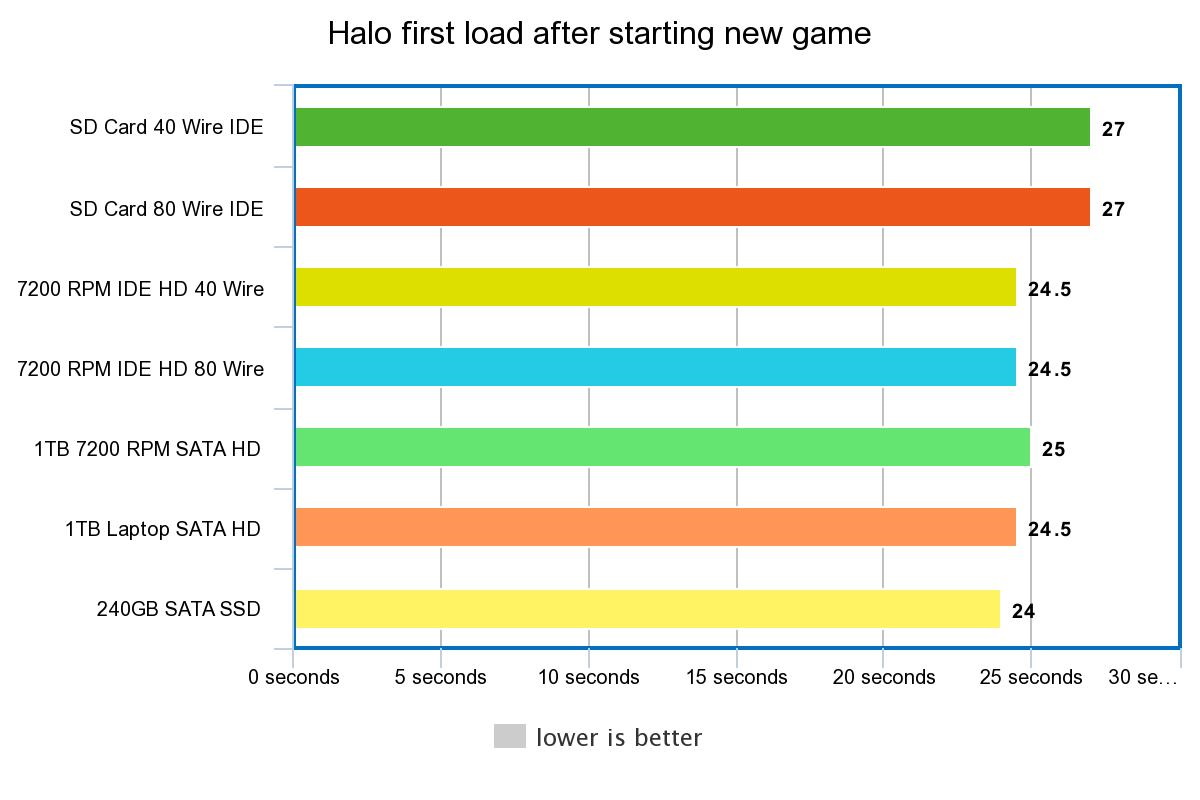
Halo is another games that does heavy drive caching of data and game assets to the drive. I saw somewhere around 750 megabytes copied to the drive during the load screen after starting the game during the loading screen. Once again the SD card is the slowest while all the other drives are all but identical.
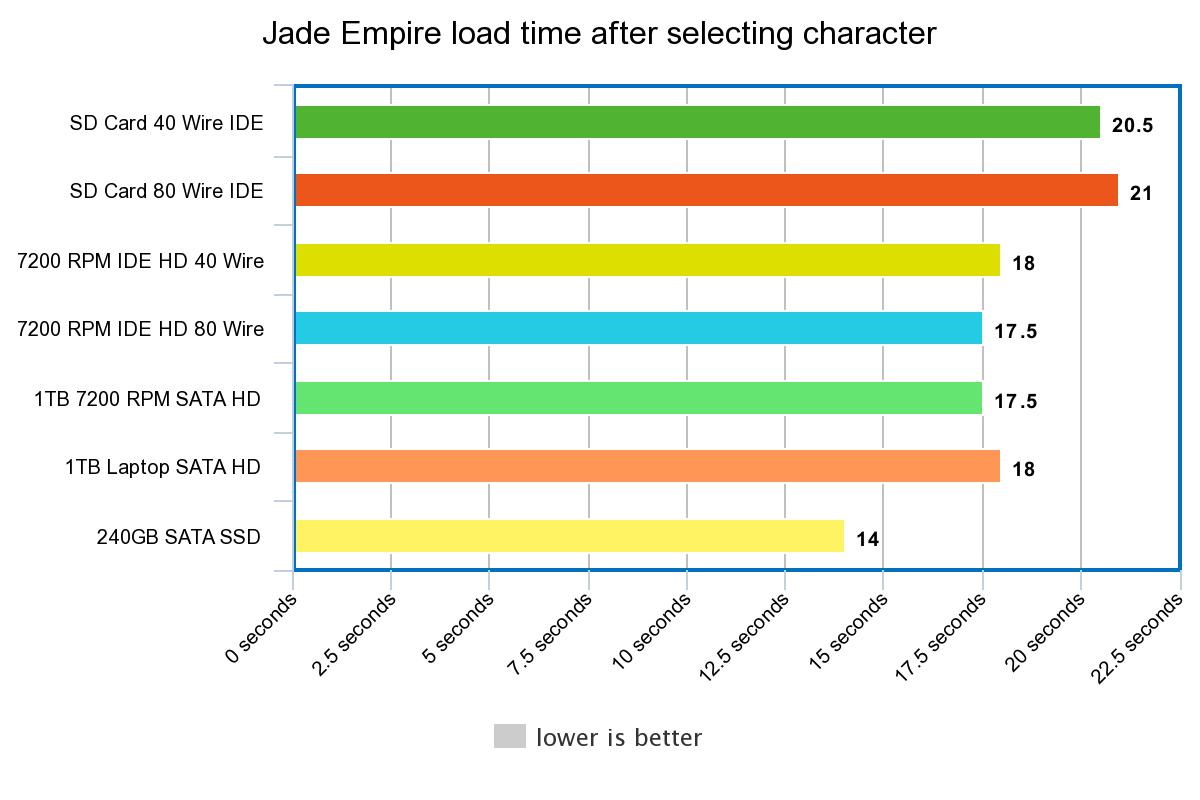
Jade Empire really, really likes the SSD showing a solid 25% performance increase over the spinning drives. All of the hard drives performed within 1 second of each other. And the SD card was in last place as usual.
Power consumption
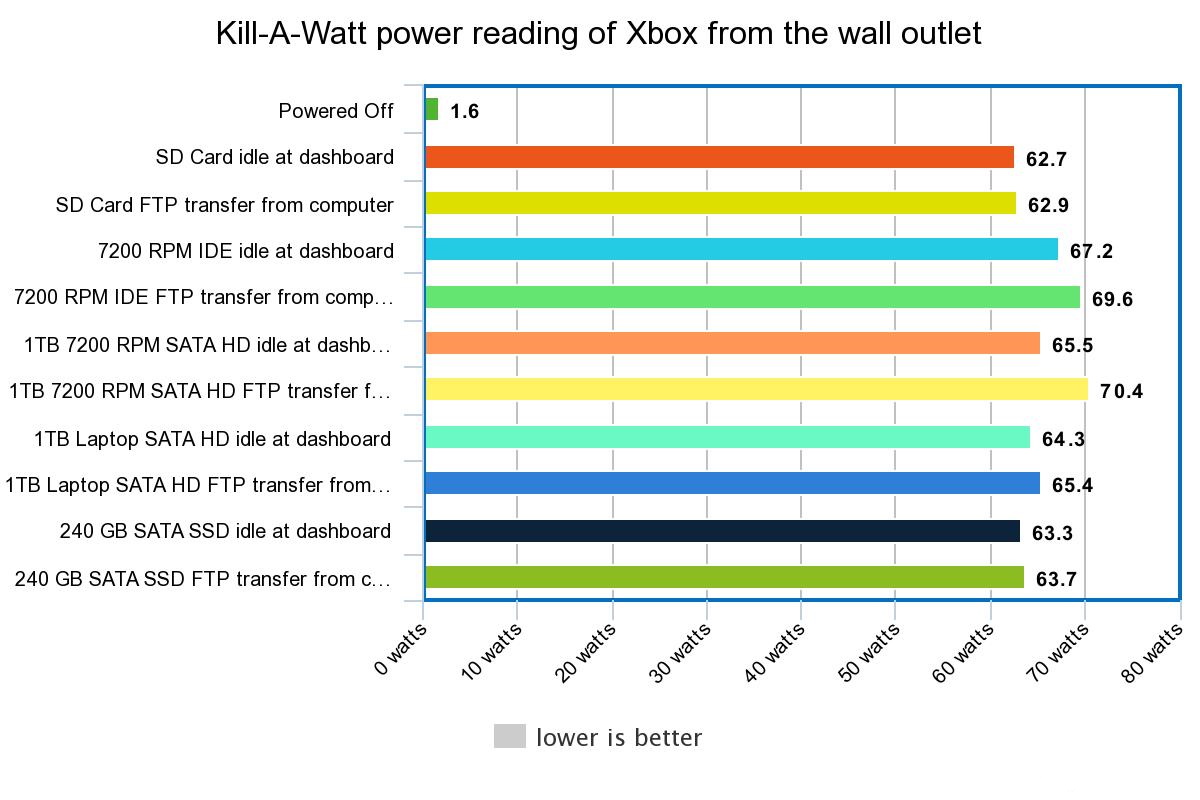
Another test I did was measuring power consumption of the Xbox with each of the drives attached to the console using a Kill-A-Watt meter. I measured both idle at the dashboard and during write transfers via FTP from my computer.
As a surprise to absolutely no one, the desktop drives are the far more power hungry devices. Although I didn’t test for heat, the WD Black SATA drive threw off a ton of heat during my tests. I really wouldn’t recommend it at all. If you use a desktop drive, stick with the cooler running 5400 RPM drives as the performance isn’t any different, but the top of the Xbox won’t feel like it’s going to go nuclear.
The laptop drive was an interesting one. While on the chart it looks to be middle of the pack in terms of power consumption, one thing to note about them is that they typically have really aggressive power saving options built in. They will spin down the drive at virtually every opportunity. I noticed at some points that the power consumption on the Xbox would drop to about 60 watts with the laptop hard drive when the drive spun down.
It was really interesting to see that both the SD card and SSD only used a few tenths of a watt more when actively writing to their drives over the FTP connection than when idling. Very little spike in energy required during this.
Conclusions and Delusions
I was unable to show a massive difference between using a 40 wire vs 80 wire cable for the SD card or 7200 RPM IDE drive. There was a couple occasions where the benchmark shows a very slight improvement, but it’s within the margin of error. However the 80 wire cable might really benefit load times for games ran straight from DVD disc. But that’s a test for a different day.
Looking at the above charts it’s pretty easy to tell who the winners and losers are. Coming in with the worst performance in virtually every test (except power consumption) is the SD card. Along with mediocre load times on games, you also have a terrible cost per gigabyte ratio in comparison to the harddrives and even SSD. And add to the fact that counterfeit SD cards are commonplace, this makes the SD card as a storage upgrade for your Xbox even less appealing.
Across the board the spinning hard drives regardless of spindle speed and drive interface all perform pretty similar. With the exception of higher power consumption from the 3.5 inch desktop drives, the load times across the board are all within the margin of error of testing. So if you absolutely must have EVERYTHING and need a 2TB drive, I would probably skip any of the 3.5 inch drives and instead get a 2.5” laptop SATA harddrive. The speeds are virtually identical and the power consumption is lower. While I didn’t specifically test for heat, you can also count on far less heat being generated by the laptop style drives as well as being a quieter drive during read and writes.
And this brings us the SATA SSD. Across all load tests the SSD reigned supreme and it won in every single one of them. A narrow margin on some titles and by several seconds on others. If you need a 1TB drive or less, in my opinion the SSD is a great value. You get the fastest load times, zero noise, virtually zero heat from the drive and extremely low power usage. At 2TB, the SSD becomes a less attractive option as the cost per gigabyte climbs up a bit. But if you catch a drive on sale, go for it!
So the TL;DR is: If you are looking to upgrade the storage in your OG Xbox in 2020, I recommend either a laptop SATA hard drive or a SATA SSD combined with the Startech IDE to SATA adapter. The laptop hard drive has the same performance as the desktop drives and runs cooler and uses less power while the SSD is the speed champion. You can’t go wrong with either choice.
